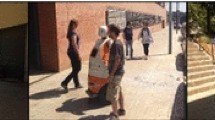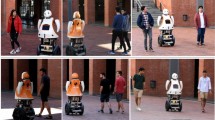Abstract
In social environments, humans mostly stay in social interactive groups with their daily activities. A mobile service robot must be aware of not only human individuals but also social interactive groups, and then behave safely and socially (politely and, respectively) in human interactive environments. In this paper, we propose a social reactive control (SRC) that enables a mobile service robot to navigate safely and socially in the human interactive environments. The SRC is derived by incorporating both states of individuals (position, orientation, motion, and human field of view) and social interactive groups (group’s types, group’s centre, group’s radius, and group’s velocity) into the conventional social force model . The SRC can be combined with a conventional path planning technique to generate a socially aware robot navigation system that is capable of controlling mobile service robots to traverse with socially acceptable behaviours. We validate the effectiveness of the proposed social reactive control through a series of real-world experiments.





Similar content being viewed by others
Explore related subjects
Discover the latest articles, news and stories from top researchers in related subjects.References
Arras KO, Mozos OM, Burgard W (2007) Using boosted features for the detection of people in 2d range data. In: IEEE international conference on robotics and automation, pp 3402–3407
Daniel C, Daniel H, Karl T (2015) Towards human-safe navigation with pro-active collision avoidance in a shared workspace. In: IROS 2015 workshop on on-line decision-making in multi-robot coordination
Ferrer G, Garrell A, Sanfeliu A (2013) Robot companion: a social-force based approach with human awareness-navigation in crowded environments. In: IEEE/RSJ international conference on intelligent robots and systems, pp 1688–1694
Hall ET (1963) A system for the notation of proxemic behavior. Am Anthropol 65:1003–1026
Hart PE, Nilsson NJ, Raphael B (1968) A formal basis for the heuristic determination of minimum cost paths. IEEE Trans Syst Sci Cybern 4(2):100–107
Helbing D, Molnr P (1995) Social force model for pedestrian dynamics. Phys Rev E 51:4282–4286
Kavraki LE, Svestka P, Latombe JC, Overmars MH (1996) Probabilistic roadmaps for path planning in high-dimensional configuration spaces. IEEE Trans Robot Autom 12(4):566–580
Kruse T, Pandey AK, Alami R, Kirsch A (2013) Human-aware robot navigation: a survey. Robot Auton Syst 61:1726–1743
LaValle SM, Kuffner JJ Jr (2001) Randomized kinodynamic planning. Int J Robot Res 20(5):378–400
Moussaid M, Perozo N, Garnier S, Helbing D, Theraulaz G (2010) The walking behaviour of pedestrian social groups and its impact on crowd dynamics. PLoS One 5(4):e10,047
Munaro M, Basso F, Menegatti E (2012) Tracking people within groups with rgb-d data. In: IEEE/RSJ international conference on intelligent robots and systems, pp 2101–2107
Ng AY, Russell SJ (2000) Algorithms for inverse reinforcement learning. In: Proceedings of the seventeenth international conference on machine learning, pp 663–670
Pantic M, Vinciarelli A (2014) Social signal processing. The Oxford Handbooks of Affective Computing, p 84
PrimeSense NITE (2011) http://www.openni.org. Accessed 6 August 2012
Quigley M, Gerkey B, Conley K, Faust J, Foote T, Leibs J, Berger E, Wheeler R, Ng A (2009) ROS: an open-source Robot Operating System. ICRA Workshop Open Source Softw 32:151–170
Ratsamee P, Mae Y, Ohara K, Kojima M, Arai T (2013) Social navigation model based on human intention analysis using face orientation. In: IEEE/RSJ international conference on intelligent robots and systems, pp 1682–1687
Rios-Martinez J, Spalanzani A, Laugier C (2011) Understanding human interaction for probabilistic autonomous navigation using risk-rrt approach. In: IEEE/RSJ international conference on intelligent robots and systems, pp 2014–2019
Rios-Martinez J, Spalanzani A, Laugier C (2014) From proxemics theory to socially-aware navigation: a survey. Int J Soc Robot 7:137–153
Setti F, Russell C, Bassetti C, Cristani M (2015) F-formation detection: individuating free-standing conversational groups in images. PLoS One 10(5):e0123,783
Shiomi M, Zanlungo F, Hayashi K, Kanda T (2014) Towards a socially acceptable collision avoidance for a mobile robot navigating among pedestrians using a pedestrian model. Int J Soc Robot 6(3):443–455
Siegwart R, Nourbakhsh IR, Scaramuzza D (2011) Introduction to autonomous mobile robots. MIT Press, Cambridge
Stentz A (1994) The d* algorithm for real-time planning of optimal traverses. Tech. rep., Tech. Rep. CMU-RI-TR-94-37, The Robotics Institute, Carnegie-Mellon University
Truong XT, Ngo TD (2016) Dynamic social zone based mobile robot navigation for human comfortable safety in social environments. Int J Soc Robot 8(5):663–684
Truong XT, Voo NY, Ngo TD (2015) RGB-D and laser data fusion-based human detection and tracking for socially aware robot navigation framework. In: Proceedings of the 2015 IEEE conference on robotics and biomimetics, pp 608–613
Vinciarelli A, Pantic M, Bourlard H (2009) Social signal processing: survey of an emerging domain. Image Vis Comput 27(12):1743–1759
Zanlungo F, Ikeda T, Kanda T (2011) Social force model with explicit collision prediction. EPL (Europhys Lett) 93(6):68,005
Author information
Authors and Affiliations
Corresponding author
Rights and permissions
About this article
Cite this article
Truong, XT., Yoong, V.N. & Ngo, TD. Socially aware robot navigation system in human interactive environments. Intel Serv Robotics 10, 287–295 (2017). https://doi.org/10.1007/s11370-017-0232-y
Received:
Accepted:
Published:
Issue Date:
DOI: https://doi.org/10.1007/s11370-017-0232-y




